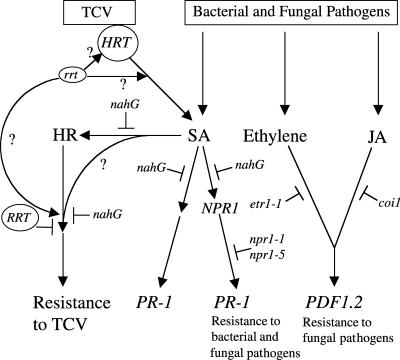Figure 10.
Model for Induction of the HR and Resistance to TCV.
Inoculation of TCV on resistant Arabidopsis results in an HR at the point of inoculation and the accumulation of SA (Dempsey et al., 1997). Development of the HR is mediated by the dominant HRT gene. Resistance is regulated by HRT and a second gene, RRT. The product of the dominant RRT allele or alleles present in susceptible ecotypes may act as a suppressor (T-bars) of the HRT-mediated resistance pathway downstream of SA and HR. Alternately, the protein encoded by the recessive rrt allele in Di-17 may directly or indirectly interact with HRT or a component downstream in the HRT-mediated defense pathway to facilitate transduction of the signal leading to TCV resistance. Although HRT is required for resistance, it is unclear if the HR is necessary also (question marks). Initiation of the HR and the signaling steps leading to resistance are blocked (T-bars) in plants expressing the nahG gene encoding salicylate hydroxylase. SA-mediated signaling leading to PR-1 expression is transduced by both NPR1-dependent and NPR1-independent pathways, which are blocked by the expression of nahG. The NPR1-dependent pathway, utilized for the activation of resistance to some bacterial and fungal pathogens, is not required for the HR or resistance to TCV. Ethylene- or JA-mediated signaling that leads to PDF1.2 expression and resistance to some fungal and bacterial pathogens is not necessary for the HR or resistance to TCV because mutations resulting in insensitivity to ethylene (etr1-1) or JA (coi1-1) do not affect either of these phenotypes. Thus, the pathways required for resistance to TCV differ from those for bacterial or fungal pathogens.

